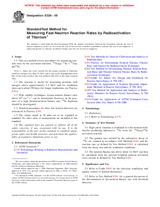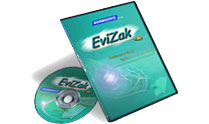Wir benötigen Ihre Einwilligung zur Verwendung der einzelnen Daten, damit Sie unter anderem Informationen zu Ihren Interessen einsehen können. Klicken Sie auf "OK", um Ihre Zustimmung zu erteilen.
ASTM E526-08
Standard Test Method for Measuring Fast-Neutron Reaction Rates by Radioactivation of Titanium
Automatische name übersetzung:
Standard Test Method for Measuring Schnellneutronenreaktionsgeschwindigkeitenvon Radioaktivierungs von Titanium
NORM herausgegeben am 1.7.2008
Informationen über die Norm:
Bezeichnung normen: ASTM E526-08
Anmerkung: UNGÜLTIG
Ausgabedatum normen: 1.7.2008
SKU: NS-47096
Zahl der Seiten: 4
Gewicht ca.: 12 g (0.03 Pfund)
Land: Amerikanische technische Norm
Kategorie: Technische Normen ASTM
Die Annotation des Normtextes ASTM E526-08 :
Keywords:
activation reaction, cross section, dosimetry, nuclear metrology, pressure vessel surveillance, reaction rate, titanium, Activation reactions, Dosimetry, Fast neutron flux/fluence, Neutron activation reactions, Nuclear metrology, Nuclear reactor vessels--surveillance, Pressure vessel surveillance, Radioactivation--fast neutron flux, Threshold detectors--1.6 MeV, ICS Number Code 17.240 (Radiation measurements), 27.120.30 (Fissile materials and nuclear fuel technology)
Ergänzende Informationen
| Significance and Use | ||||||||||||||||
|
Refer to Guide E 844 for the selection, irradiation, and quality control of neutron dosimeters. Refer to Test Method E 261 for a general discussion of the determination of fast-neutron fluence rate with threshold detectors. Titanium has good physical strength, is easily fabricated, has excellent corrosion resistance, has a melting temperature of 1675°C, and can be obtained with satisfactory purity. 46Sc has a half-life of 83.79 days. The 46Sc decay emits a 0.8893 MeV gamma 99.984 % of the time and a second gamma with an energy of 1.1205 MeV 99.987 % of the time. The isotopic content of natural titanium recommended for 46Ti is 8.25 %. The radioactive products of the neutron reactions 47Ti(n,p)47Sc (τ1/2 = 3.3492 d) and 48Ti(n,p)48Sc (τ1/2 = 43.67 h), might interfere with the analysis of 46Sc. Contaminant activities (for example, 65Zn and 182Ta) might interfere with the analysis of 46Sc. See Sections 7.1.2 and 7.1.3 for more details on the 182Ta and 65Zn interference. 46Ti and 46Sc have cross sections for thermal neutrons of 0.59 and 8 barns, respectively ; therefore, when an irradiation exceeds a thermal-neutron fluence greater than about 2 × 1021 cm–2, provisions should be made to either use a thermal-neutron shield to prevent burn-up of 46Sc or measure the thermal-neutron fluence rate and calculate the burn-up. Fig. 1 shows a plot of cross section versus neutron energy for the fast-neutron reactions of titanium which produce 46Sc [that is, NatTi(n,X)46Sc]. Included in the plot is the 46Ti(n,p) reaction and the 47Ti(n,np) contribution to the 46Sc production, normalized (at 14.7 MeV) per 46Ti atom. This figure is for illustrative purposes only to indicate the range of response of the 46Ti(n,p) reaction. Refer to Guide E 1018 for descriptions of recommended tabulated dosimetry cross sections. |
||||||||||||||||
| 1. Scope | ||||||||||||||||
|
1.1 This test method covers procedures for measuring reaction rates by the activation reactions 46Ti(n,p) 46Sc + 47Ti(n, np)46Sc. Note 1—Since the cross section for the (n,np) reaction is relatively small for energies less than 12 MeV and is not easily distinguished from that of the (n,p) reaction, this test method will refer to the (n,p) reaction only. 1.2 The reaction is useful for measuring neutrons with energies above approximately 4.4 MeV and for irradiation times up to about 250 days (for longer irradiations, see Practice E 261). 1.3 With suitable techniques, fission-neutron fluence rates above 109 cm–2·s–1 can be determined. However, in the presence of a high thermal-neutron fluence rate, 46Sc depletion should be investigated. 1.4 Detailed procedures for other fast-neutron detectors are referenced in Practice E 261. 1.5 The values stated in SI units are to be regarded as standard. No other units of measurement are included in this standard. 1.6 This standard does not purport to address all of the safety concerns, if any, associated with its use. It is the responsibility of the user of this standard to establish appropriate safety and health practices and determine the applicability of regulatory limitations prior to use. |
||||||||||||||||
| 2. Referenced Documents | ||||||||||||||||
|
Empfehlungen:
EEviZak – alle Gesetze einschließlich ihrer Evidenz in einer Stelle
Bereitstellung von aktuellen Informationen über legislative Vorschriften in der Sammlung der Gesetze bis zum Jahr 1945.
Aktualisierung 2x pro Monat!
Brauchen Sie mehr Informationen? Sehen Sie sich diese Seite an.




 Cookies
Cookies
